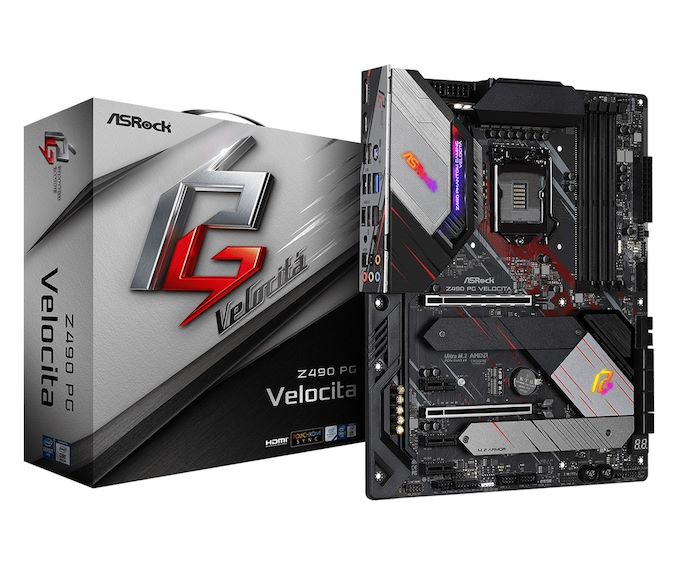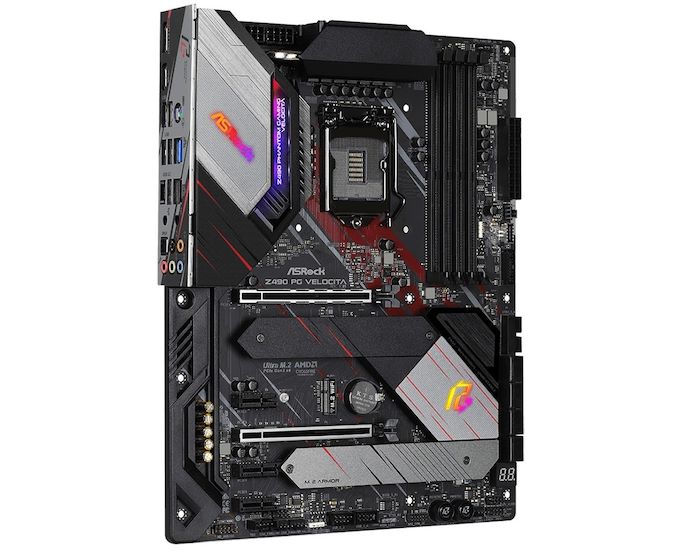The ASRock Z490 PG Velocita Motherboard Review: It Means SPEED
by Gavin Bonshor on September 21, 2020 9:00 AM ESTConclusion
When Intel launched the Z490 chipset to support its 10th Generation Comet Lake processors, the biggest differences came in the new LGA1200 socket, and also the promise of additional supported components, such as Intel 2.5G ethernet and updated Wi-Fi. The Z490 chipset spawned a wide variety of new models, including ASRock, who gave us the PG Velocita, with a mid-range feature set at a mid-range price. The $250 to $300 price point is a highly contested market, where vendors have to get it right as mid-ranged motherboards are on now on the level of what high-end models were a good few years ago.
Catering the gamers among us, the ASRock Z490 PG Velocita is visually pleasing with multiple areas of customizable RGB zones, with red and grey accents on a primarily black background. It includes a solid feature set with dual PCIe 3.0 x4/SATA M.2 slots and plenty of support for SATA devices with eight ports available in total. Only six of these include support for RAID 0, 1, 5, and 10 support, while the other two are powered by an ASMedia SATA controller, which makes them useful for non-storage devices such as optical disc drives. Included on the rear panel is a pair of USB 3.2 G2 ports, including one Type-C and one Type-A, with four USB 3.2 G1 Type-A ports. Users can add more ports with a USB 3.2 G1 Type-C front panel header, two USB 3.2 G1 Type-A headers for four points, and two USB 2.0 headers, which can be used for RGB controllers, as well as providing an extra four ports.
ASRock makes a point of marketing future support for PCIe 4.0, which Intel's next-generation Rocket Lake processors look to bring to the table, so ASRock includes PCIe 4.0 re-drivers and clock generator for the top full-length PCIe slot and the top-mounted PCIe M.2 slot. Focusing on the now, there are two full-length PCIe 3.0 slots that operate at x16/+x4, with three PCIe 3.0 x1 slots. The x16/x4 combination is a bit odd, normally we would expect an x8/x8 split for users that want to add in extra high-bandwidth PCIe devices, such as a dual M.2 card or similar. For onboard audio, ASRock includes a Realtek ALC1220 HD audio codec, with a Texas Instruments NE5532 amplifier, which gives the front panel header a better range, with support for up to 600 Ohms.
In our performance testing, the ASRock Z490 PG Velocita breezed through our suite competitively, with a couple of wins in our system tests. For out of the box DPC latency at default settings, the PG Velocita is the best performer in this test, while it also has the lowest power consumption at full load with default CPU settings. We saw good performance in our overclock testings, too, with tight VDroop control thanks to the firmware reverting the LLC to level 1 when any alterations to the CPU VCore were made. The PG Velocita also uses an active design for its power delivery, which is effective at cooling but comes at the cost of extra noise.
A PG (Velocita) Tip: Add Wi-Fi 6
Looking at the PG Velocita's networking support, it includes a pair of RJ45 Ethernet ports, one powered by a premium Realtek RTL8125BG 2.5 G Ethernet controller, while the other is driven by an Intel I219-V Gigabit controller. Surprisingly at the price point, ASRock decided not to include Wi-Fi capability, although it includes a Key-E M.2 slot and space on the rear panel I/O shield should users wish to install their own. Due to the Z490's native support for Wi-Fi 6 CNVi, this would have been nice to see included on a model at this price point, given most of the competition does at this price point. The thing to consider isn't just the Wi-Fi 6 capability, but the BT 5.0/5.1 support which allows users to connect wireless controllers such as Scuf game pads. In speaking to other vendors, adding Wi-Fi support typically adds $10-$15 to the end-user pricing.
To conclude things, the ASRock Z490 PG Velocita has an MSRP of $260, while when on sale it is usually around $245 at both Amazon and Newegg. This makes it an even sweeter deal despite not including a wireless interface. Other models at a similar price point, including GIGABYTE, MSI, and ASUS, all include Wi-Fi 6 on its models, but if wireless capability isn't a requirement, the Z490 PG Velocita is a solid option with very competitive performance throughout.












16 Comments
View All Comments
YB1064 - Monday, September 21, 2020 - link
It would be nice if you can thrown in a comparable dataset from an AMD system. It wouldn't be remiss to cut out motherboard gaming benchmarks altogether. The motherboard stopped being a factor cince, 2001 (?)Udyr - Monday, September 21, 2020 - link
Although I agree with you that some comparison is necessary for the majority of users to have a "visual" difference vs other products, the board has always been a factor. Bad VRM, conductor and other important parts of it have to work properly for the overall system to have good stability, otherwise you start having random issues or, worst case scenario, fried componentsYB1064 - Monday, September 21, 2020 - link
The stress tests should bring out any issues with the VRM. Gaming benchmarks don't add much to a MB review.oRAirwolf - Tuesday, September 22, 2020 - link
I think it is good just to validate that there are no glaring performance issues that haven't been addressed. I agree that the benchmarks are pretty much useless otherwise though.AMDSuperFan - Monday, September 21, 2020 - link
Why didn't they benchmark this system with an AMD CPU in it? Scared?Tomatotech - Tuesday, September 22, 2020 - link
Absolutely agree. Don’t forget the hammer to help install an AMD cpu in it. The benchmarks won’t be great though.mattkiss - Monday, September 21, 2020 - link
Hmm...Buildzoid didn't like this mobo very much: https://www.youtube.com/watch?v=qmKiwDL3UrAwhatthe123 - Monday, September 21, 2020 - link
Seems more accurate than this review. This review just focuses on general performance out of the box if a normal single gpu config, so yes it's similar in performance with but with better DPC latency.Problem is other models at this price point have more features and/or more efficient/powerful VRM design that doesn't require a bunch of little fans. The little fans are what help it drop VRM temps down to the 60s, but most VRMs don't really have any degradation problems even at in the 90Cs, so it's not clear what the price premium is paying for except DPC latency.
mattkiss - Wednesday, September 23, 2020 - link
"This review just focuses on general performance out of the box if a normal single gpu config, so yes it's similar in performance with but with better DPC latency."Not sure I understand your statement...both reviews are of the ASRock Z490 PG Velocita.
whatthe123 - Friday, September 25, 2020 - link
I meant that as in, this review compares the velocita in a single GPU config against other motherboards then just checks the results, whereas buildzoid's review actually looks into what features the board provides and how it manages to achieve its results i.e. a bunch of proprietary small fans when competitors have passive cooling more than good enough to keep VRMs stable.The conclusion anandtech's review makes only makes sense if you ignore all the other features offered by competitors. Otherwise it doesn't make sense because you're paying the same price and getting fewer features on top of having more moving parts that can fail.